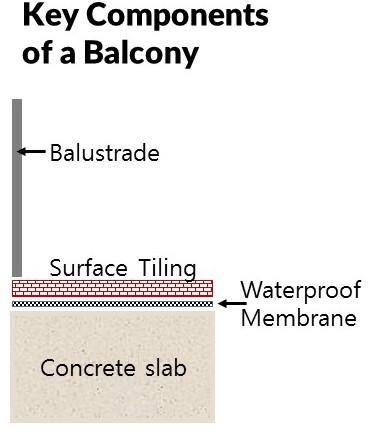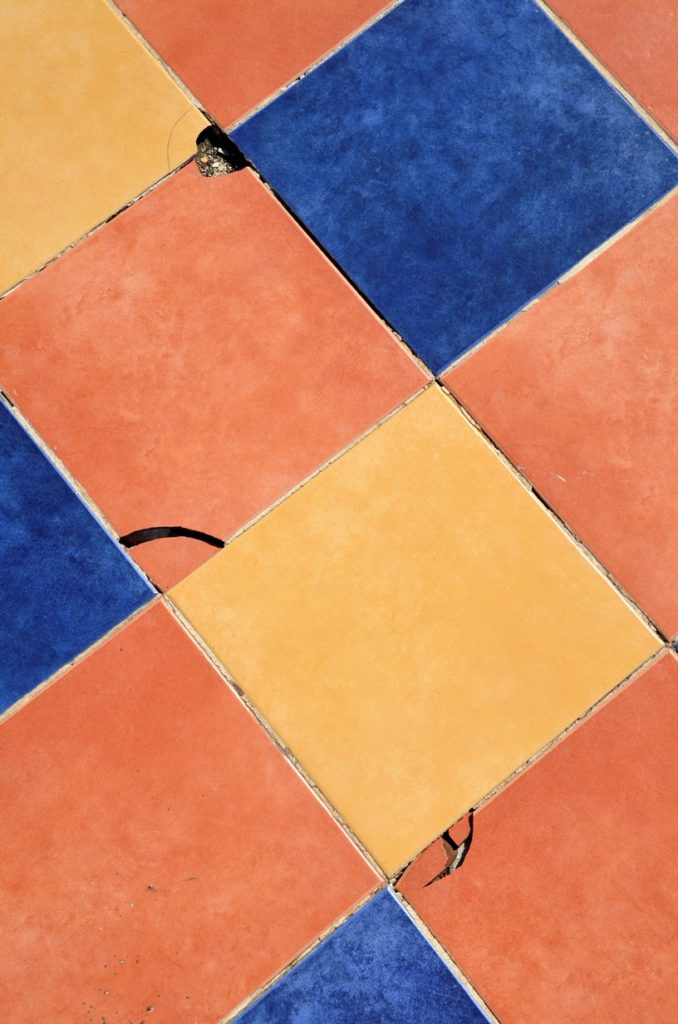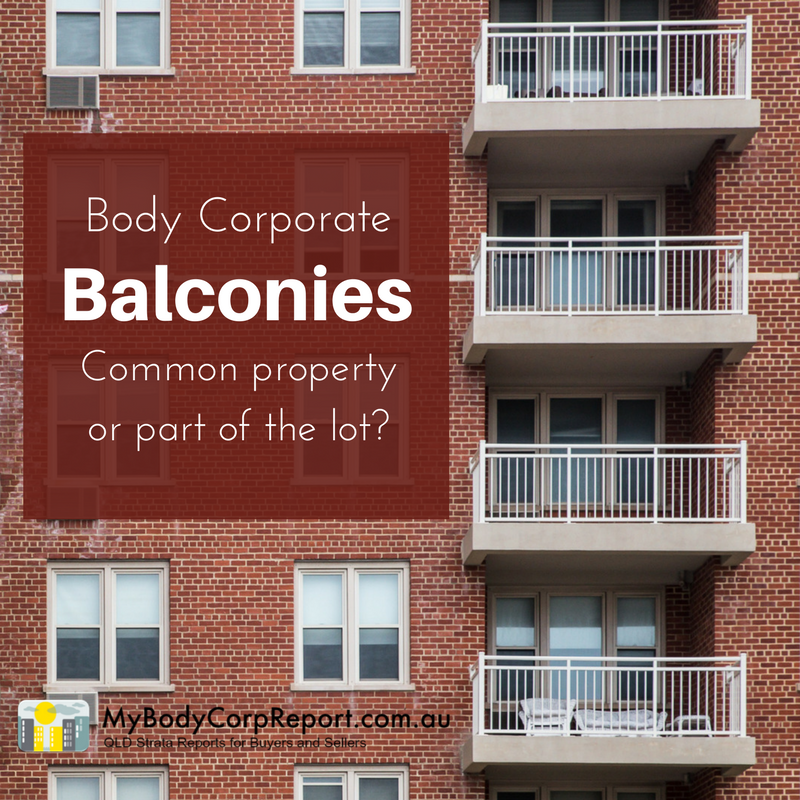Body corporate balconies cause a surprising amount of drama. This Melbourne waterproofing website reports:
A recent insurance survey has shown that “Balcony Waterproofing” has the highest failure rate of all areas in the building envelope.
As you’ll see below there are many common ways in which balconies fail. This article will explore the issues that arise with balconies and who is responsible for rectification.
Please do note that balconies and their components are complex. Much of what I’m discussing is a simplified overview to give some direction and its entirely possible I’ll say something that’s too simplistic or even misleading. In all situations you’ll need to check with your building professional.
So … Is It Common Property or Part of the Lot?

A balcony has several key components:
- the balustrade
- surface tiling (or other material)
- waterproof membrane
- the concrete slab
The balustrade is the exterior boundary of the building therefore is common property and body corporate responsibility.
NOTE: If the balustrade looks out over an exclusive use area it is not considered on the boundary of common property and will be lot owner responsibility. Thanks to Michael for the tip!
The surface tiling is wholly contained within the lot and is lot owner responsibility.
Waterproof membranes are also contained within the lot. However, Regulations require the body corporate to maintain in good order roofing membranes that are not common property but that provide protection for lots and / or common property. That includes balcony waterproof membranes.
The boundaries of the lot are half way between the walls, floor, ceilings and doors, meaning midway in the concrete slab two lots, or a lot and common property meet. When infrastructure serves two or more lots it is common property and body corporate responsibility.
Doors or Windows onto a Balcony

In majority of cases the balcony is part of the lot.
The doors that access the balcony are wholly contained within the lot and are lot owner responsibility.
Any windows from the lot onto the balcony are also lot owner responsibility.
Occasionally balconies are allocated as exclusive use. Refer to your by-laws for the terms of the exclusive use allocations.
If the area is exclusive use it usually, subject to the terms of the allocation, comes down to a question of what is “maintenance” and what is a “structural”.
The Most Common Issues With Body Corporate Balconies
A well maintained concrete balcony should last for 40 – 50 years.
Other than “well maintained” there are other underlying assumptions including:
- The balcony was well designed in the first place with good drainage.
- The balcony and all it’s components were well constructed.
- Good quality and location appropriate materials were used in construction.
Sadly, body corporate balconies often fail to meet those basic assumptions.
Water Leaks
The most common issue with body corporate balconies is, by far, water ingress. From the same Melbourne waterproofing site above:
1.8% of the total construction cost is spent on waterproofing membranes for balcony areas, and yet leaking balconies account for a staggering 83% of building defect complaints.
Water leaks from a balcony can be into the lot or common property below or beside or into the subject lot.
Adequate drainage is the first issue that should be checked. An incorrect fall (resulting from poor design or construction) can funnel water directly into the lot or away from the appropriate drains.
Water pooling in also indicates poor draining.
Leaks to the lot below are, usually, indicators of a failure of the waterproof membrane.
There are lots of reasons membranes fail but poor workmanship accounts for up to 90% of failures. That can be everything from the slab being too wet to bond with the membrane, poor preparation of the surface, poor application of the membrane or subsequent tearing of the membrane when tiles are added or afterwards.
I’ve seen three building where waterproof membranes where simply never applied to balconies.
Leaks into the lot are more problematic since the failure may be the windows and doors rather than the balconies themselves. Or, as is often the case, the leaks have multiple causes.
If you have water ingress issues from your balcony have your own sliding doors checked first. If that proves not to be the cause of ingress then report the matter to your body corporate.
If you have water ingress from the lot above or common property report straight to the body corporate.
Cracked or “Drummy” tiles

Tiles are laid over the waterproof membrane to which they bond providing protection for the membrane which itself stops water leaking into the lot below and protects the slab.
Sometimes expansion joints are inadequate and the tiles push against each other as the slab moves. When that happens the tiles can become de-bonded from the membrane and lift becoming “drummy”, named because of the hollow drumming sound they make with struck with something heavy.
Read more about lifting or drummy tiles here.
Cracked tiles are, usually, the result of some sort of impact though it is possible that underlying issues can cause tiles to move and crack.
Cracked or lifted tiles need to be repaired as soon as possible. Movement of the tiles can tear the waterproof membrane. Even if the tiles come away cleanly it opens the way for water to penetrate to the membrane. It will have no way to drain away and can cause deterioration.
Repair of drummy or cracked tiles is lot owner responsibility.
If the cause of the problem comes from a structural issue such as concrete spalling the repair will be the body corporate responsibility.
See below a discussion re who is responsible for tiles when the works are body corporate responsibility.
Deterioration of the Balustrade or Fittings

Balustrades are made of all sorts of materials such as concrete, steel, wood or glass. They’re also fixed to the slab by either cementing in place or a complex arrangement of bolts.
All the materials are open to the elements and erosion or other deterioration will happen.
Regular maintenance is crucial. Concrete and steel balustrades should be painted regularly as painting seals the structure and prevents rust. Wooden balustrades, usually part of a wooden balcony, need to be treated regularly and inspected for evidence of wood rot and / or timber pests. Glass balustrades need to be cleaned and inspected regularly.
The most common balustrade issue is a breakdown of the connection to the slab. If bolts are used they can rust weakening the structure.
When Balustrades No Longer Meet Australian Standards
Balustrades, like all building items, are subject to Australian Standards. Australian Standards are made more rigid, reasonably often, certainly more often than balcony balustrades are changed.
The changes to the Standards are not retroactive so if a non-compliant balustrade remains in good order then it’s a not an issue. The balustrade may be maintained, indefinitely.
There comes a point however when maintenance becomes a repair. Balustrades that are not compliant with Australian Standards may not be repaired.
It is common for a strata scheme with balustrade issues to find that replacement is their only option.
Concrete Cancer

Concrete cancer, or more correctly concrete spalling, is common in coastal areas.
Unchecked concrete spalling will destroy a building. The Iluka building, a Surfers Paradise icon built in the 1970’s, was demolished in 2013 because it had become structurally unsound due to spalling.
For most buildings concrete cancer is a treatable problem.
Regular painting is crucial. The paint seals the concrete against moisture penetration. Painting goes hand in hand with inspection of the building and, if identified, repair of any spalling.
Balconies are checked and painted regularly in concrete buildings as part of their regular maintenance.
Brick buildings by contrast don’t need regular painting and balcony slabs are sometimes overlooked. The exposed concrete slab for the balcony should still be both inspected, painted and repaired if necessary.
Waterproofing Works To Body Corporate Balconies
The body corporate is responsible for maintaining the waterproof membrane in a good condition. The owner is responsible for the tiles on top of that membrane.
So what happens when the tiles need to be removed to address an issue with the membrane?
A lot will depend on the condition of tiles and the reasons the membrane needs addressing.
If the membrane is leaking but the tiles on top of the membrane are in good condition then the body corporate is responsible for the cost of removing the tiles, rectifying the membrane and relaying similar tiles. If the lot owner would like upgraded tiles they may pay the extra cost.
If the condition of the tiles is poor things are less clear. An order has been made that the lot owner is responsible for the cost to purchase and re-lay the tiles, notwithstanding the waterproofing works are necessary, because the condition of the current tiles was poor.
In this Blue Lagoon decision a lot owner sought reimbursement for tiling works as the water was pooling under the tiles, allegedly causing the tiles to lift and crack. The application was dismissed for several reasons including that the works had already begun prior to communication with the body corporate about possible problems. As the scheme had no way to check validity of the claims the owner’s application for reimbursement was dismissed.
Renovating a Balcony
Making changes to your balcony is something that should be discussed with the body corporate prior to any works being undertaken. Tiles that have been laid well bond with the waterproof membrane below and removing them without damage is a challenge.
A conversation at the beginning might avoid drama later.
Conclusion
This article is intended as an overview of the body corporate balconies, where they go wrong and who is responsible for fixing what.
It is a complex subject, both in terms of the physical make up of a balcony and determining where fault and financial liability lie.
Persistence, communication and reliable building professionals are key to smooth resolution of issues.

